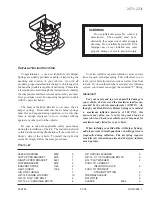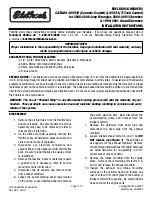
AUTOMATIC TRANSMISSION
FLUID CHECK
Have an authorized dealer check and
change the transmission fluid and filter at
the correct service interval. See
Do not use supplemental transmission
fluid additives, treatments or cleaning
agents. The use of these materials may
affect transmission operation and result
in damage to internal transmission
components.
Checking Automatic Transmission
Fluid
Check and change the fluid at the
scheduled intervals. See
transmission does not consume fluid.
However, the fluid level should be checked
if the transmission is not working properly,
such as if the transmission slips or shifts
slowly or if you notice some sign of fluid
leakage.
Automatic transmission fluid expands
when warmed. To obtain an accurate fluid
check, drive the vehicle until it is at normal
operating temperature, approximately
20 mi (30 km). Verify that the transmission
fluid temperature gauge, located on the
instrument cluster, is within normal range.
1.
Drive the vehicle 20 mi (30 km)until it
reaches normal operating temperature.
2. Park the vehicle on a level surface and
engage the parking brake.
3. With the engine running, parking brake
engaged and your foot on the brake
pedal, move the gearshift lever through
all of the gear ranges. Allow sufficient
time for each gear to engage.
4. Latch the gearshift lever in park (P) or
neutral (N) and leave the engine
running.
5. Remove the dipstick, wiping it clean
with a clean, dry lint free rag. If
necessary, refer to the Under Hood
Overview in this chapter for the
location of the dipstick.
6. Install the dipstick making sure it is fully
seated in the filler tube.
7.
Remove the dipstick and inspect the
fluid level. The fluid should be in the
designated area for normal operating
temperature or ambient temperature.
Low Fluid Level
E163740
Do not drive the vehicle if there is no
indication of fluid on the dipstick and the
ambient temperature is above 50°F
(10°C).
Correct Fluid Level
E163742
200
F650750 (TBC), enUSA, First Printing
Maintenance
















































